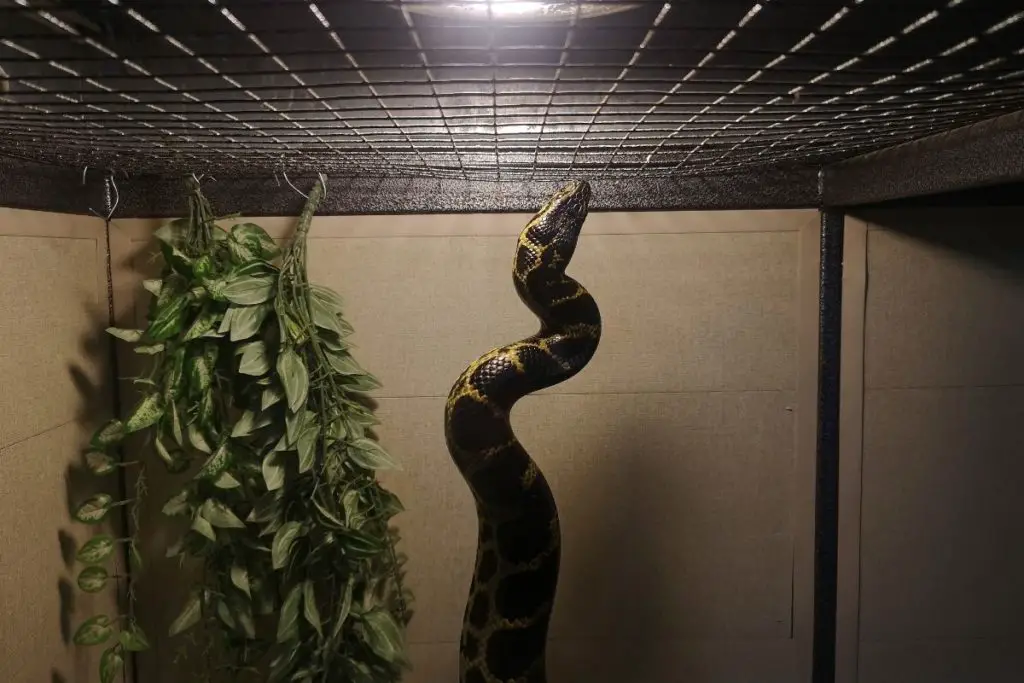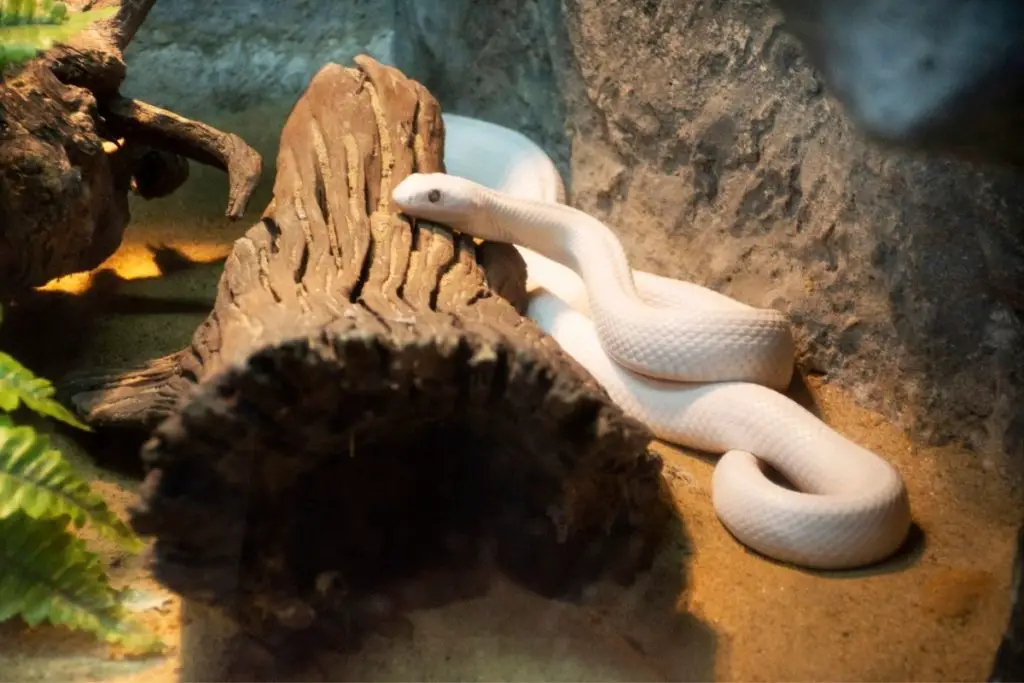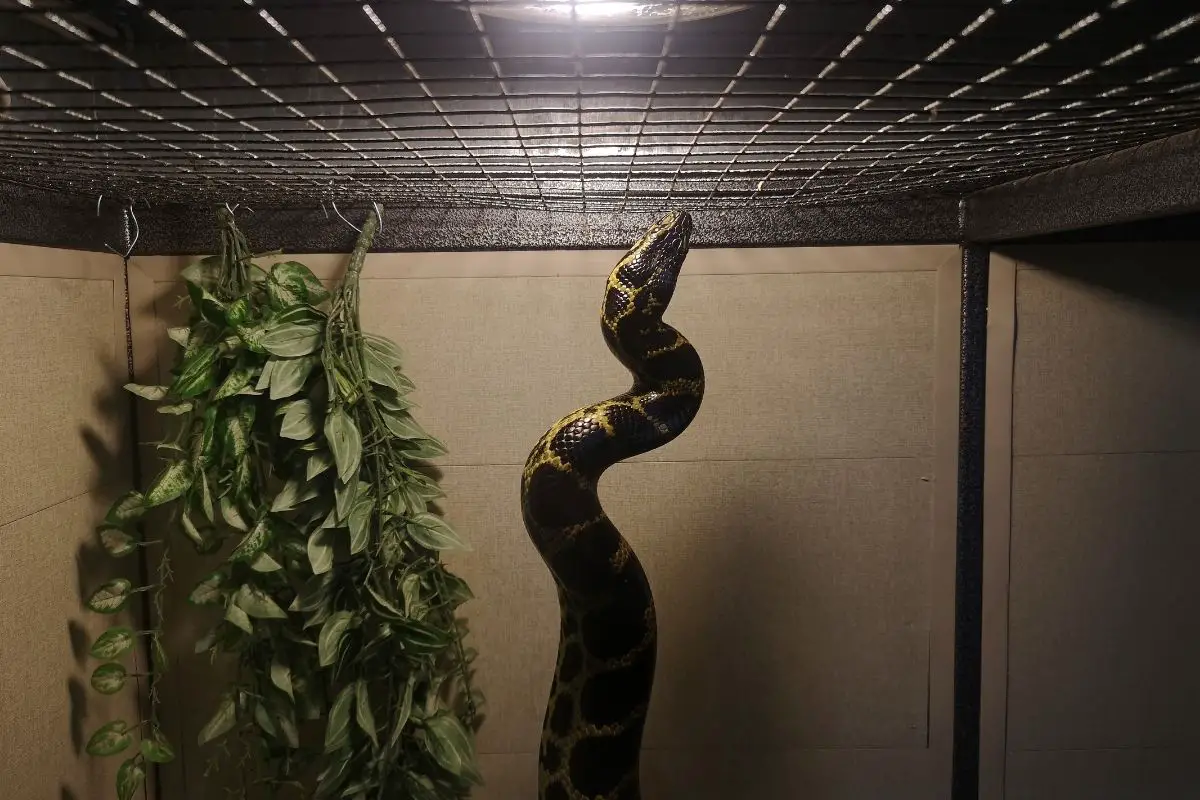Snakes are solitary creatures that don’t have many ways of expressing themselves, and so we don’t really know how they feel about most things.
And although we can’t ask them directly, we can imagine how living your whole life in a small cage can be an unpleasant experience, or are we measuring things by human standards when we think about it this way?
To answer this question, I’ve asked a few different vets and experts, and got surprisingly contradicting opinions.
So, do snakes like being in cages? Snakes are incapable of liking or disliking being in cages because snakes have a very limited mental capacity and don’t think in the same way we or most other mammals do, but a snake will like its cage as long as it’s the right size, humidity, temperature, and provides safety and hiding spots.
The truth is that snakes live very different lives than we do and have very different perspectives on their world and their life, and in this article, I’m going to do my best to summarize what the experts believe on the topic and why it may not be so cruel to keep a snake in a cage its whole life after all.
Contents
How do Snakes think about cages?

To understand how snakes feel about their cages, it’s important to keep in mind how snakes live in the wild. Snakes do not create dens as other animals do, and neither do they take over territories as mammals do.
In fact, most snakes do not have homes of any sort. Snakes are simply wanderers, they will sleep when they find somewhere suitable and safe, and they will come back to the same place to hibernate sometimes.
Snakes are solitary creatures, they live their whole lives alone, and the only times you will find more than one snake in a place is either during mating or during hibernation when they huddle for warmth. You can learn more about this in my post on snake hibernating in houses.
This is all to introduce you to the fact that snakes do not have houses or territories, and they don’t really understand these concepts. Snakes also do not understand freedom or captivity. If a snake’s needs are met, it’s fine.
How Snakes live their lives
Snakes live their lives hunting prey and looking for a mate. Snakes do not feel pleasure or happiness, or at least snakes don’t feel or show happiness in the ways mammals do or understand.
They also have a very limited range of emotions, and none of these emotions really related to them being in captivity or free. Snakes just live to eat and mate. They can only feel fear (such as when they feel threatened by predators), hunger, and the desire to mate.
Snakes can not feel sad, lonely, or happy, they are simpler than that.
When do snakes like or dislike their cages?
Snakes will not like or dislike their cages based on the captivity or freedom it gives them, as discussed earlier, snakes have no grasp of such concepts. However, snakes can still have a liking or disliking to their cages based on whether their life, overall, in this cage is a good life or not.
What makes a good cage for a snake?

Typically, the cage you build for your snake must be tailored to the particular demands of its species. The cage should also be as large as possible to fit the snake.
For instance, snakes from 6 to 36 inches long require at least a 10 or 20 gallon tank, but if you have a small snake, such as a juvenile python, it may live in a plastic container (cut tiny air vents!). Keep in mind that you need to move your snake to a larger container as it grows bigger so it will remain comfortable.
The majority of snakes cages are commercially made, however, some prefer to build the cages themselves with glass, fiberglass, Plexiglas, or even wood (but keep in mind that wood will be more difficult to keep clean and disinfected).
It’s ideal to build a terrarium with rocks, plants, and tree branches in order to establish a somewhat natural environment for the snake to be more at home; however, these are more difficult to maintain.
Keep in mind that this theory has no scientific backing, and I personally believe this doesn’t really make such a difference, especially if you are buying a captivity-bred snake since it has never been in the wild anyway and doesn’t really know what it’s missing.
However, any snake cage, regardless of size or species, should have proper ventaliation. It should also be proofed against escaping with sealed seams and secure tops that can be locked. You can consult with a veterinarian or check specialized pet stores to provide you with recommendations fo these kind of cage to help you choose the right one for your snake.
Keep in mind that if your snake keeps trying to get out, then probably something is wrong, and you can learn the 13 reasons your snake is trying to escape here.
Does your snake’s cage need bedding?
Your snake’s cage does need bedding. It’s best that the bedding material is easy to keep clean and free of harmful chemicals.
Some of the ideal materials for cage bedding include butcher paper, newspapers, towels, or artificial grass. However, materials like wood shavings, sand, cat litter, or travel, are not ideal for cage bedding and should be avoided as it’s difficult to clean them and may cause health problems to the snake if ingested by accident.
If you’re using artificial grass, you can cut it into pieces and place one piece inside the cage on the bottom, while keeping the rest of the pieces outside. Once the piece inside the cage gets too dirty, you will be able to get it replaced with a clean piece from outside.
When the inside of the cage gets dirty, you can clean it with water and regular soap (It’s best to avoid any cleaning substances with harsh chemicals), then rinse it thoroughly and leave it to dry.
A good source of heat is a MUST

All reptiles require some form of heat. Ectotherms or cold-blooded species, such as snakes depend on environmental or external heat sources to keep their body temperatures stable. Keep in mind that snakes will not survive days (or sometimes even hours) without a source of heat in their cages.
They require a temperature range to keep their body temperature stable, it would be impossible for them to thrive in an enclosure with only one temperature. So, their cage should ideally have an established heat gradient, with one part having more warmth than the rest.
To ensure you achieve this gradient, you need to purchase two unbreakable thermometers, then put one of them at the part of the cage where it’s cold and the other at the part of the cage where it’s warm.
The cage’s temprature should somewhat reflect what the snake would experience in a natural environment, and it should be as close as possible to the region where it originated. On average, it’s recommended that the temperature in the colder part of the cage should be between 70°-75° F, while the temperature in the warmer part should be between 90°-95°F.
When it comes to the main heat source, you can use an incandescent bulb of 100 watts with a reflector hood. Other sources of heat are ceramic infrared heat emitters or heat lamps, which can be purchase at any specialized pet shop.
Keep in mind that any source of heat should be placed on the outside from above one part the cage. It should also be covered with screened lid to ensure the snake is protected from burning itself.
It’s importnat to ensure that the heat source cannot be accidentally tipped over or placed in direct contact with the snake, which could result in serious burns and injury. Do not use hot rocks for heating as they get too hot for your pet (they can also cause escape attempts).
You can use heated pads underneath the cage for more warmth, however, make sure to consult a vet to determine the right way to use them.
What about humidity in the cages?
The requirement fro humidity depending on the location and season. Some houses are unsuitable for snakes as they’re too dry or too humid.
Generally, many snake species thrive in a humidity range of 40 to 70 percent. If the humidity is too high, it can be hazardous as well as cause health issues. It’s clear that desert-dwelling species require lower humidity.
Do Snakes need UVB light?
Snakes do not need UVB light. While it is true that most reptiles need UV-B light as a source of vitamin D (which is necessary for the absorption of dietary calcium), most snakes get enough Vitamin D from their diets.
Howver, captive animals should be checked by a veterinarian at least once a year to make sure they are receiving adequate nutrition and that their calcium levels remain within the normal range. Do not use UVA/UVB lights unless you know your pet requires them for health reasons.
Helpful Resources
Spatial considerations for captive snakes
Territorial Behavior in Snakes and the So-Called Courtship Dance
What Do Rattle Snake Dens Look Like?
If you like this article, please share it!


